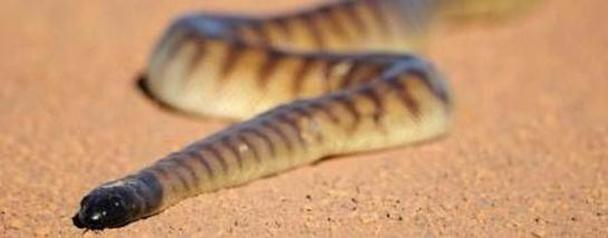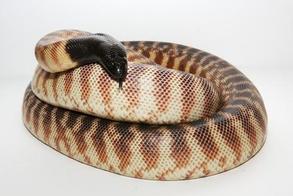
The black-headed python can survive in a wide range of climates and conditions, with the exception of the driest and extremely arid environments. The species prefers habitats like savannas and dry scrublands, but they are also found in forests or agricultural farmland.
They are found at elevations up to 200 feet (60 m) above sea level. The black-headed pythons are nocturnal animals and have adapted themselves to surviving in the hot and dry conditions of their habitats. In colder temperatures, they will use termite nests to burrow, if available, as a way of stabilizing their body temperature.
Their characteristic shiny black head is also used regulate its body temperature, they can extend only their head outside its burrow while most of the body remains covered to heat up. On the other hand, if they need to cool down the black-headed python may bury their black head in the sand.
Although they are capable swimmers, black-headed pythons are rarely found in the water. They can also climb and the black-headed python is occasionally found in trees. They will hiss loudly if disturbed or harassed and sometimes strike with a closed mouth.
These pythons don't have heat sensing pits like other Australian python species such as the spotted python and the venomous pit vipers. These specialized organs are used for tracking endothermic prey like mammals or birds, detecting even the smallest temperature changes.
But since the black-headed python feeds most on cold-blooded reptiles it has no need for such a developed organ. Instead, they have an equivalent sensory organ in their rostral scales just like their close relative the Woma python (Aspidites ramsayi).
They are preyed upon by several animals such as birds of prey, dingoes and the northern quoll (Dasyurus hallucatus). These snakes can live anywhere from 20 to 30 years, both in the wild and captivity.
 Their distinctive black color is present in the head but also runs down the neck for about 20 scales, and in juvenile snakes, it can extend even further to ventral scales.
Their distinctive black color is present in the head but also runs down the neck for about 20 scales, and in juvenile snakes, it can extend even further to ventral scales.The color of the body varies from brownish, yellow to a reddish tan, normally with some irregular dark brown bands.
The black-headed python color varies extensively depending on geographic location and age.The black-headed python average length ranges from 5 to 6,5 ft (1.5 to 2 m) females grow longer than males.
They have a cylindrical and slender body and adult specimens weigh 35 pounds (16 kg) on average.The species is also known as black-headed rock python or simply rock python, but it's not to be confused with the African rock python.
Other common names include Terry tar pot or tar pot, because of their distinctive black head, giving it the appearance that it was dipped in tar or black ink. The Pilbara region Nyangumarta aboriginals use the name "Purruyura" for the species.
The black-headed python can survive in a wide range of climates and conditions, with the exception of the driest and extremely arid environments. The species prefers habitats like savannas and dry scrublands, but they are also found in forests or agricultural farmland.
They are found at elevations up to 200 feet (60 m) above sea level. The black-headed pythons are nocturnal animals and have adapted themselves to surviving in the hot and dry conditions of their habitats. In colder temperatures, they will use termite nests to burrow, if available, as a way of stabilizing their body temperature. Their characteristic shiny black head is also used regulate its body temperature, they can extend only their head outside its burrow while most of the body remains covered to heat up. On the other hand, if they need to cool down the black-headed python may bury their black head in the sand. Although they are capable swimmers, black-headed pythons are rarely found in the water. They can also climb and the black-headed python is occasionally found in trees. They will hiss loudly if disturbed or harassed and sometimes strike with a closed mouth. These pythons don't have heat sensing pits like other Australian python species such as the spotted python and the venomous pit vipers. These specialized organs are used for tracking endothermic prey like mammals or birds, detecting even the smallest temperature changes. But since the black-headed python feeds most on cold-blooded reptiles it has no need for such a developed organ. Instead, they have an equivalent sensory organ in their rostral scales just like their close relative the Woma python (Aspidites ramsayi). They are preyed upon by several animals such as birds of prey, dingoes and the northern quoll (Dasyurus hallucatus). These snakes can live anywhere from 20 to 30 years, both in the wild and captivity. 
Their distinctive black color is present in the head but also runs down the neck for about 20 scales, and in juvenile snakes, it can extend even further to ventral scales.
The color of the body varies from brownish, yellow to a reddish tan, normally with some irregular dark brown bands. The black-headed python color varies extensively depending on geographic location and age.The black-headed python average length ranges from 5 to 6,5 ft (1.5 to 2 m) females grow longer than males. They have a cylindrical and slender body and adult specimens weigh 35 pounds (16 kg) on average.The species is also known as black-headed rock python or simply rock python, but it's not to be confused with the African rock python. Other common names include Terry tar pot or tar pot, because of their distinctive black head, giving it the appearance that it was dipped in tar or black ink. The Pilbara region Nyangumarta aboriginals use the name "Purruyura" for the species.
Subspecies / Taxonomy
The black-headed python was first described in 1864 by Johann Ludwig Krefft one of Australia's first zoologists and paleontologists. There are no subspecies are currently recognized by scientists for the black-headed python. Diet / Feeding The black-headed python feeds primarily on other reptiles, mostly skinks but also bearded dragons, geckos, legless lizards even the perentie (Varanus giganteus) which is Australia's largest monitor lizard. Other smaller snakes, including some of the most venomous snakes in the world, are also eaten by the black-headed python since they are completely immune to their highly toxic venom. They will on rare occasions also eat mammals or even birds if the opportunity should arise. Since the black-headed python is a non-venomous snake it uses constriction to subdue and kill the prey before consuming it whole. Reproduction The black-headed python is monogamous, but sometimes males and females may engage in extra-pair copulations. Male black-headed pythons will engage each other over the right to breed with a female. Like other python species, the black-headed python is oviparous. Female snakes lay their eggs during October and November and incubate them by coiling around them for approximately 2 months before they hatch. Although the males aren't as aggressive as most python species mating and courtship it sometimes involves ritualistic combats or biting. Some captive snakes have been bred as young as two and half years but in the wild, these snakes reach sexual maturity at the age of 4 to 5 years. The hatchlings are on average 2 ft (60 cm) in length at birth and capable of fending for themselves immediately. Conservation / Threats The black-headed python has not been evaluated by the IUCN and there is a lack of available information with regards to their population trends. But the species is considered widespread and abundant throughout their range. The species isn't listed in CITES. One potential threat to these snakes like many others is the exotic pet trade, but since the majority of individuals found in the pet trade are captive bred, the risk is low. The sales of black-headed pythons as pets or for breeding purposes has become relatively common in northern Australia. |
No comments:
Post a Comment